List of extinct cetaceans
The list of extinct cetaceans features the extinct genera and species of the order Cetacea. The cetaceans (whales, dolphins and porpoises) are descendants of land-living mammals, the even-toed ungulates. The earliest cetaceans were still hoofed mammals. These early cetaceans became gradually better adapted for swimming than for walking on land, finally evolving into fully marine cetaceans.
This list currently includes only fossil genera and species. However, the Atlantic population of gray whales (Eschrichtius robustus) became extinct in the 18th century, and the baiji (or Chinese river dolphin, Lipotes vexillifer) was declared "functionally extinct" after an expedition in late 2006 failed to find any in the Yangtze River.
Suborder Archaeoceti
Family Ambulocetidae
(Eocene)

Family Basilosauridae
(Late Eocene)
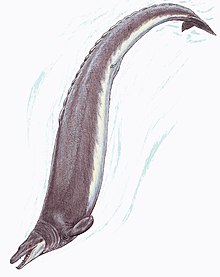
Family Kekenodontidae
(Oligocene)
Family Pakicetidae
(Early to Middle Eocene)

Family Protocetidae
(Eocene)
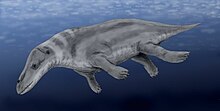
Family Remingtonocetidae
(Eocene)
Suborder Mysticeti
Family Aetiocetidae
(Oligocene)

Family Llanocetidae
(Late Eocene-Early Oligocene)
Family Mammalodontidae
(jr synonym Janjucetidae)
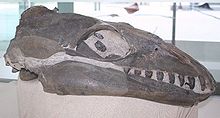
(Late Oligocene)
Family incertae sedis
Clade Chaeomysticeti
Family incertae sedis
Superfamily Eomysticetoidea
Family Cetotheriopsidae
(Oligocene to Miocene)
Family Eomysticetidae
(Oligocene to early Miocene)
Family Aglaocetidae
(Miocene)
Superfamily Balaenoidea
Family Balaenidae
(Miocene to Recent)
- Antwerpibalaena
- Archaeobalaena[8]
- Balaena
- Balaenella
- Balaenotus
- Balaenula
- Eubalaena (extant)
- Idiocetus
- Peripolocetus
- Protobalaena
Family incertae sedis
Clade Thalassotherii
Family Cetotheriidae
(Miocene - Pliocene)
Classification follows Steeman (2007) unless otherwise noted.[9]

- Brandtocetus
- Cephalotropis
- Cetotherium
- Ciuciulea
- Eucetotherium
- Halicetus
- Herentalia
- Herpetocetus
- Hibacetus[10]
- Joumocetus
- Kurdalagonus
- Metopocetus
- Mithridatocetus
- Nannocetus

Parietobalaena palmeri skull - Piscobalaena
- Thinocetus
- Titanocetus[11]
- Tiucetus
- Vampalus
- Zygiocetus[12]
Family Diorocetidae
(Miocene to Pliocene)
Family Neobalaenidae
(Miocene to Recent)
Family Pelocetidae
(Miocene)
Family incertae sedis
Superfamily Balaenopteroidea

Family Balaenopteridae
(Miocene to Recent)
- Archaebalaenoptera
- Balaenoptera (extant)
- "Balaenoptera" cortesii
- "Balaenoptera" portisi
- "Balaenoptera" ryani
- Burtinopsis
- Cetotheriophanes
- Fragilicetus[14]
- Incakujira
- Miobalaenoptera
- Norrisanima
- Nehalaennia
- Parabalaenoptera
- Plesiobalaenoptera
- Plesiocetus
- Praemegaptera
- Protororqualus
Family Eschrichtiidae
(Miocene to Recent)
Family Tranatocetidae
Family incertae sedis
- Mioceta (nomen dubium)
- Piscocetus
- Siphonocetus (nomen dubium)
- Tretulias (nomen dubium)
- Ulias (nomen dubium)
Suborder Odontoceti
Basal forms
Family Agorophiidae
(Late Oligocene)
Family Ashleycetidae
(Early Oligocene)
Family Mirocetidae
(Early Oligocene)
Family Patriocetidae
(Oligocene to Early Miocene)
Family Simocetidae
(Late Oligocene)
Family Xenorophidae
(Oligocene)
Family Inticetidae
Family Microzeuglodontidae
Family Squaloziphiidae
(Early Miocene)
Family incertae sedis
Superfamily Squalodontoidea
Family Dalpiazinidae
(Late Oligocene to Miocene)
Family Prosqualodontidae
(Oligocene to Miocene)
Family Squalodontidae
(Oligocene to Pliocene)
- Austrosqualodon
- Eosqualodon
- Macrophoca
- Pachyodon
- Squalodon (syn. Kelloggia, Rhizoprion, Crenidelphinus, Arionius, Phocodon)
- Smilocamptus
- Tangaroasaurus
Superfamily Physeteroidea
Family Kogiidae
(Miocene to recent)
- Aprixokogia
- Kogia (extant)
- Koristocetus
- Nanokogia
- Pliokogia
- Praekogia
- Scaphokogia
- Thalassocetus
Family Physeteridae
- Aulophyseter
- Diaphorocetus
- Ferecetotherium
- Idiophyseter
- Idiorophus
- Orycterocetus
- Physeterula
- Placoziphius
- Preaulophyseter
Family incertae sedis
- Acrophyseter
- Albicetus
- Brygmophyseter
- Eudelphis
- Helvicetus (nomen dubium)
- Hoplocetus (nomen dubium)
- Kogiopsis
- Livyatan[18]
- Miokogia (nomen dubium)
- Paleophoca (nomen dubium)
- Placoziphius
- Prophyseter (nomen dubium)
- Scaldicetus (nomen dubium)
- Zygophyseter
Superfamily "Eurhinodelphinoidea"
Family Argyrocetidae
(Late Oligocene to Early Miocene)
Family Eoplatanistidae
(Miocene)
Family Eurhinodelphinidae
(Mid Miocene to Pliocene)
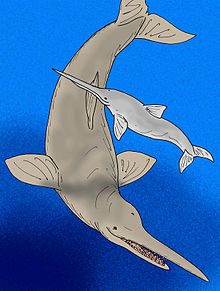
- Ceterhinops
- Eurhinodelphis
- Iniopsis
- Mycteriacetus
- Phocaenopsis
- Schizodelphis
- Vanbreenia
- Xiphiacetus
- Ziphiodelphis
Superfamily Platanistoidea
Family Allodelphinidae
(Early to Middle Miocene)

Family Platanistidae
(Miocene to Recent)
Family Squalodelphinidae
(Early to Late Miocene)
Family Waipatiidae
Superfamily Ziphioidea
Family Ziphiidae
(Miocene to Recent)
- Basal forms
- Subfamily Berardiinae
- Subfamily Hyperoodontinae
- Africanacetus
- Ihlengesi
- Khoikhoicetus
- Mesoplodon (extant)
- Nenga
- Pterocetus
- Xhosacetus
- Subfamily Ziphiinae
- Subfamily incertae sedis
Clade Delphinida
Family Kentriodontidae
(Early-Middle Miocene)

Family incertae sedis
- Anacharsis
- Belonodelphis
- Delphinavus
- Graamocetus
- Hadrodelphis
- Lamprolithax
- Leptodelphis
- Liolithax
- Lophocetus
- Loxolithax
- Macrokentriodon
- Microphocaena
- Miodelphis
- Nannolithax
- Oedolithax
- Oligodelphis
- Palaeophocaena
- Pithanodelphis
- Platylithax
- Prionodelphis
- Protodelphinus
- Sarmatodelphis
- Sophianacetus
- Tagicetus
Superfamily Delphinoidea
Family Albireonidae
(Miocene to Pliocene)
Family Delphinidae

(Oligocene to Recent)
- Arimidelphis
- Astadelphis
- Australodelphis
- Delphinus (extant)
- Eodelphinus
- Etruridelphis
- Hemisyntrachelus
- Lagenorhynchus (extant)
- Norisdelphis
- Orcinus (extant)
- Platalearostrum[24]
- Protoglobicephala
- Pseudorca (extant)
- Septidelphis[25]
- Sinanodelphis
- Stenella (extant)
- Tursiops (extant)
Family Monodontidae
(Miocene to Pliocene)
Family Odobenocetopsidae
(Pliocene)
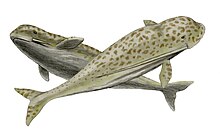
Family Phocoenidae
(Miocene to Recent)
- Archaeophocaena
- Australithax
- Brabocetus
- Haborophocoena
- Lomacetus
- Miophocaena
- Numataphocoena
- Piscolithax
- Pterophocaena
- Salumiphocaena
- Semirostrum[26]
- Septemtriocetus
Superfamily Inioidea
Family Iniidae
Family Pontoporiidae
(Middle Miocene to Recent)
Superfamily Lipotoidea
Family Lipotidae
(Miocene to Recent)
Superfamily incertae sedis
Family incertae sedis
- Acrodelphis
- Champsodelphis
- Hesperocetus
- Imerodelphis (Miocene)
- Kharthlidelphis
- Lonchodelphis
- Macrochirifer
- Microcetus
- Microsqualodon
- Neosqualodon
- Pelodelphis
- Rhabdosteus (nomen dubium)
- Sulakocetus
See also
References
- ^ http://deepblue.lib.umich.edu/bitstream/2027.42/57499/1/Vol%2031%20No%2013%20final%2012-19-07.pdf
- ^ Gingerich, P.D.; et al. (2001). "Origin of Whales from Early Artiodactyls: Hands and Feet of Eocene Protocetidae from Pakistan". Science. 293: 2239–2242. doi:10.1126/science.1063902. PMID 11567134.
- ^ a b Bajpai, Sunil; Thewissen, J.G.M. (2014). "Protocetid cetaceans (Mammalia) from the Eocene of India". Palaeontologia Electronica. 17 (3): 34A.
- ^ Philip D. Gingerich and Henri Cappetta (2014). "A New Archaeocete and Other Marine Mammals (Cetacea and Sirenia) from Lower Middle Eocene Phosphate Deposits of Togo". Journal of Paleontology. 88 (1): 109–129. doi:10.1666/13-040.
- ^ Bebej, Ryan M.; Zalmout, Iyad S.; Abed El-Aziz, Ahmed A.; Mohammed; Antar, Sameh M.; Gingerich, Philip D. (2016). "First remingtonocetid archaeocete (Mammalia, Cetacea) from the middle Eocene of Egypt with implications for biogeography and locomotion in early cetacean evolution". Journal of Paleontology. 89: 882–893. doi:10.1017/jpa.2015.57.
- ^ Marx, Felix G.; Tsai, Cheng-Hsiu; Fordyce, R. Ewan (2015). "A new Early Oligocene toothed 'baleen' whale (Mysticeti: Aetiocetidae) from western North America: one of the oldest and the smallest". Royal Society Open Science. 2 (12): 150476. doi:10.1098/rsos.150476. PMC 4807455. PMID 27019734.
- ^ Geisler, Jonathan H.; Boessenecker, Robert W.; Brown, Mace; Beatty, Brian L. (2017). "The Origin of Filter Feeding in Whales". Current Biology. 27: 2036–2042.e2. doi:10.1016/j.cub.2017.06.003. PMID 28669761.
- ^ Yoshihiro Tanaka; Hitoshi Furusawa; Masaichi Kimura (2020). "A new member of fossil balaenid (Mysticeti, Cetacea) from the early Pliocene of Hokkaido, Japan". Royal Society Open Science. 7 (4): Article ID 192182. Bibcode:2020RSOS....792182T. doi:10.1098/rsos.192182. PMC 7211833. PMID 32431893.
- ^ M. E. Steeman (2007). "Cladistic analysis and a revised classification of fossil and recent mysticetes". Zoological Journal of the Linnean Society. 150 (4): 875–894. doi:10.1111/j.1096-3642.2007.00313.x.
{{cite journal}}: Cite has empty unknown parameter:|month=(help) - ^ Otsuka, H.; Ota, Y. (2008). "Cetotheres from the early Middle Miocene Bihoku Group in Shobara District, Hiroshima Prefecture, West Japan". Miscellaneous Reports of the Hiwa Museum for Natural History. 49 (2): 1–66.
- ^ Bisconti, M. (2006). "Titanocetus, a new baleen whale from the middle Miocene of northern Italy (Mammalia, Cetacea, Mysticeti)". Journal of Vertebrate Paleontology. 26 (2): 344–354. doi:10.1671/0272-4634(2006)26[344:tanbwf]2.0.co;2. JSTOR 4524574.
- ^ Tarasenko, K. K. (2014). "Novye rody usatykh kitov (Cetacea, Mammalia) iz miotsena Severnogo Kavkaza i Predkavkaz'ya. 3. Zygiocetus gen. nov. (srednii sarmat, Adygeya)". Paleontological Journal. 48 (5).
- ^ "A new marine vertebrate assemblage from the Late Neogene Purisima Formation in Central California, part II: Pinnipeds and Cetaceans". Geodiversitas. 35 (4): 815–940. 2013. doi:10.5252/g2013n4a5.
{{cite journal}}: Unknown parameter|authors=ignored (help) - ^ Bisconti, M.; Bosselaers, M. (2016). "Fragilicetus velponi: a new mysticete genus and species and its implications for the origin of Balaenopteridae (Mammalia, Cetacea, Mysticeti)". Zoological Journal of the Linnean Society. 177: 450–474. doi:10.1111/zoj.12370.
- ^ Kellogg, R. (1934). "A new cetothere from the Modelo Formation at Los Angeles, California". Carnegie Institution of Washington. 447: 83–104.
- ^ Churchill, Morgan; Martinez-Caceres, Manuel; De Muizon, Christian; Mnieckowski, Jessica; Geisler, Jonathan H. (2016). "The Origin of High-Frequency Hearing in Whales". Current Biology. 26 (16): 2144–2149. doi:10.1016/j.cub.2016.06.004. PMID 27498568.
- ^ Fitzgerald, E.M.G. (2004). "A review of the Tertiary fossil Cetacea (Mammalia) localities in Australia". Memoirs of Museum Victoria. 61 (2): 183–208.
- ^ Lambert, O.; Bianucci, G.; Post, K.; de Muizon, C.; Salas-Gismondi, R.; Urbina, M.; Reumer, J. (2010). "The giant bite of a new raptorial sperm whale from the Miocene epoch of Peru". Nature. 466: 105–108. doi:10.1038/nature09067. PMID 20596020.
- ^ Tanaka, Yoshihiro; Fordyce, R. Ewan (2016). "Awamokoa tokarahi, a new basal dolphin in the Platanistoidea (late Oligocene, New Zealand)". Journal of Systematic Palaeontology: 1. doi:10.1080/14772019.2016.1202339.
- ^ a b Kimura, T.; Barnes, L.G. (2016). "New Miocene fossil Allodelphinidae(Cetacea, Odontoceti, Platanistoidea) from the North Pacific Ocean". Bulletin of the Gunma Museum of Natural History. 20: 1–58.
- ^ Lambert, Olivier; Bianucci, Giovanni; Urbina, Mario (2014). "Huaridelphis raimondii, a new early Miocene Squalodelphinidae (Cetacea, Odontoceti) from the Chilcatay Formation, Peru". Journal of Vertebrate Paleontology. 34 (5): 987–1004. doi:10.1080/02724634.2014.858050.
- ^ Gabriel Aguirre-Fernández and R. Ewan Fordyce (2014). "Papahu taitapu, gen. et sp. nov., an early Miocene stem odontocete (Cetacea) from New Zealand" (PDF). Journal of Vertebrate Paleontology. 34 (1): 195–210. doi:10.1080/02724634.2013.799069.
- ^ Lambert, O.; Louwye, S. (2016). "A new early Pliocene species of Mesoplodon: a calibration mark for the radiation of this species-rich beaked whale genus". Journal of Vertebrate Paleontology. 36: e1055754. doi:10.1080/02724634.2015.1055754.
- ^ Post, Klaas; Kompanje, Erwin J.O. (2010). "A new dolphin (Cetacea, Delphinidae) from the Plio-Pleistocene of the North Sea". Deinsea. 14: 1–13.
- ^ Giovanni Bianucci (2013). "Septidelphis morii, n. gen. et sp., from the Pliocene of Italy: new evidence of the explosive radiation of true dolphins (Odontoceti, Delphinidae)". Journal of Vertebrate Paleontology. 33 (3): 722–740. doi:10.1080/02724634.2013.744757.
- ^ Racicot, Rachel A.; Deméré, Thomas A.; Beatty, Brian L.; Boessenecker, Robert W. (2014). "Unique Feeding Morphology in a New Prognathous Extinct Porpoise from the Pliocene of California". Current Biology. 24: 774–779. doi:10.1016/j.cub.2014.02.031. PMID 24631245.



